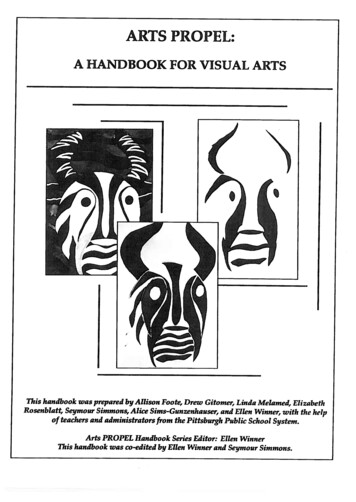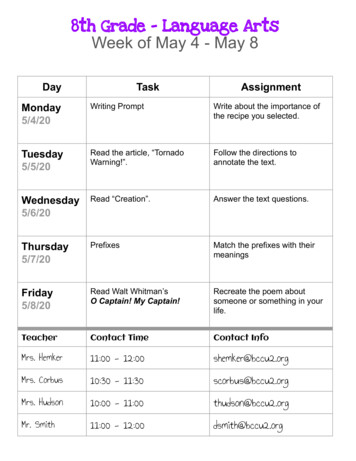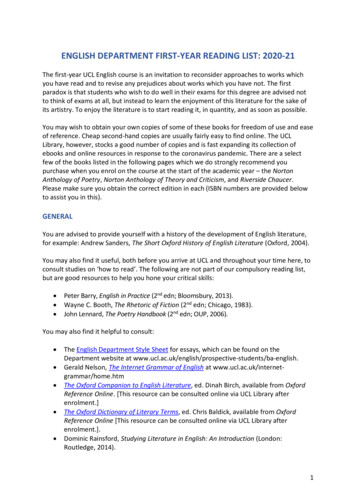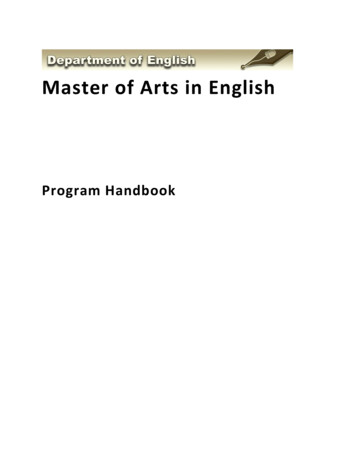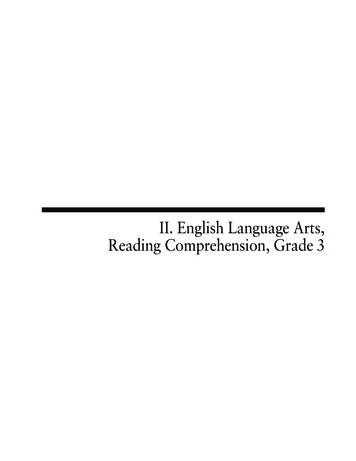
Transcription
II. English Language Arts,Reading Comprehension, Grade 3
Grade 3 English Language ArtsReading Comprehension TestThe spring 2015 grade 3 English Language Arts Reading Comprehension test was based on Pre-K–5learning standards in two content strands of the Massachusetts Curriculum Framework for EnglishLanguage Arts and Literacy (March 2011) listed below. Page numbers for the learning standards appearin parentheses. Reading (Framework, pages 13–19) Language (Framework, pages 33–40)The Massachusetts Curriculum Framework for English Language Arts and Literacy is available on theDepartment website at www.doe.mass.edu/frameworks/current.html.ELA Reading Comprehension test results are reported under two MCAS reporting categories, Readingand Language, which are identical to the two framework content strands listed above.The tables at the conclusion of this chapter indicate each released and unreleased common item’s reportingcategory and the standard it assesses. The correct answers for released multiple-choice questions are alsodisplayed in the released item table.Test Sessions and Content OverviewThe grade 3 ELA Reading Comprehension test included two separate test sessions. Each session includedreading passages, followed by multiple-choice, short-response, and/or open-response questions. Selectedcommon reading passages and approximately half of the common test items are shown on the followingpages as they appeared in grade 3 test & answer booklets.Reference MaterialsDuring both ELA Reading Comprehension test sessions, the use of bilingual word-to-word dictionaries wasallowed for current and former English language learner students only. No other reference materials wereallowed during any ELA Reading Comprehension test session.6
Grade 3 English Language ArtsReading ComprehensionDIRECTIONSThis session contains two reading selections with multiple-choice, short-response, and open-responsequestions. For multiple-choice questions, mark your answers by filling in the circle next to the bestanswer. For short-response and open-response questions, write your answer in the space below thequestion.Read the passage about Claude Monet and answer the questions that follow.Art Words andscape — a painting that shows a large area of land as itLis viewed from one place Canvas — a surface for painting made from cloth stretchedover a wooden frame Sketches — quick, rough drawings of somethingClaude Monetby Anne MaleyThe Man in the Boat12It was a sunny morning on theriver. The water slapped softly at aboat moving through the water. A manwas rowing the boat, but he was nota fisherman on his way out to catch afish. He was an artist on his way out topaint a landscape. The boat was his floating studio, or workingplace.The man found a spot on the river and began to set uphis easel. Then he watched and waited. When the light lookedjust right, he began to paint. He covered his white canvas withthe colors of trees, water, and sky. When people looked at hispainting later, he wanted them to see what he had seen — anearly summer morning on the river.7
ELA Reading Comprehension3The man in the boat lived long ago in France. He was anartist who loved the outdoors. Most of all, he loved the water.His name was Claude Monet. He is known as one of the greatestlandscape painters who ever lived.The Young Artist456789Claude Monet was born in France in 1840. He spent his earlyyears in a town where a great river ran into the sea. Claudeloved the sea.As a child, Claude was always sketching. People likedClaude’s sketches. By working hard, Claude could sketch eightpictures a day and sell them.By the time he was fifteen, Claude was already a famousartist in his home town. He sold his sketches to a shop, whichhung them in the window. The shop also showed the work ofanother artist, named Mr. Boudin.One day the two artists met at the shop. Mr. Boudin said toClaude, “So, young man, it’s you who does these little sketches.They have something in them, but why not try painting? I willbe happy to give you lessons.”At first Claude had no answer. He didn’t like Mr. Boudin’spaintings. He wasn’t sure that he wanted Mr. Boudin to teachhim to paint. Finally, Claude agreed.Mr. Boudin taught Claude how to paint sunlight and shadows.He taught Claude a great deal about painting. When the lessonsended, Claude knew that he wanted to be a painter for the restof his life. At the age of seventeen, Claude went to the city ofParis to study more about art.The Difficult Years10Art school was not what Claude had expected. The teachers atart school said that artists should paint in studios, not outdoors.They had many rules for what to paint and how to paint it.Claude could not follow these rules. He said, “I can paint onlywhat I see.”8
ELA Reading Comprehension111213Claude became very unhappy. He finally left Paris, but heheld onto his ideas, and he kept on painting. Claude paintedlandscapes in parks, near rivers, and beside the sea.Claude also painted largepictures, like “Women inthe Garden.” He painted thispicture on a canvas that waseight feet tall. First he paintedas much of the canvas as hecould reach. Then he connectedwires to the canvas. He dug ahole and lowered the canvasinto the hole. After he hadpainted the top of the canvas,he used the wires to lift thecanvas out of the hole. Thepainting was finished.Years went by. Claude Women in the Gardenpainted many pictures, but he sold very few. Still, Claude nevergave up. He loved his work and hoped that one day others wouldlove it, too.The Water Garden141516When Claude Monet was forty-two years old, he and otherartists had a large show in Paris. Monet’s paintings wereamong the best-selling works in the show. Monet felt proudand happy.After that, Monet and his family moved to a house in thecountry. Monet planted two gardens that are still there today.One was a flower garden. The other was a water garden.Monet made his water garden in the shape of a pear. Aroundthe sides he grew many kinds of flowers and trees. Then hebuilt a high wooden bridge across one end. Water lilies of manycolors floated in the water. When it was done, Monet called hisgarden “a mirror of the sky.”9
ELA Reading Comprehension171819Monet found great happiness in looking at his gardens and inpainting them. His last great work was a group of eight paintingsof the water garden called Water Lilies. He painted these as agift to France, his country. Today these paintings still hang ina special place in Paris.Each of the eight paintings shows a different part of thewater garden. As you move from one painting to another,you seem to walk around the garden from beginning to end.Because of the way Monetpainted these works, you seethe garden from morning untilnight. Walking among thesepaintings is like spending awhole day in Claude Monet’sgarden.Monet painted his WaterLilies until the day he died atthe age of eighty-six. He wasalmost blind, but he kept onpainting. He did not just wantto paint, he needed to paint.As he put it, “I paint just asWater Liliesa bird sings.”“Claude Monet” by Anne Maley, from SUNBEAMS, Student Edition. Copyright 1987 by Harcourt, Inc. Reprinted by permission ofHoughton Mifflin Harcourt Publishing Company. Portrait of Artist Claude Monet copyright Bettmann/CORBIS. “Women in the Garden” byClaude Monet copyright Alfredo Dagli Orti/The Art Archive/CORBIS. “Nymphéas” by Claude Monet copyright Reuters/CORBIS.10
ELA Reading ComprehensionMark your choices for multiple-choice questions 1 through 10 by filling in the circle next to the bestanswer.ID:285013 C Common1 ID:285015 B Common3 According to paragraph 1, ClaudeMonet used his boat as a place toAfish.Bread.Cpaint.Dsleep.Based on paragraph 3, which of thefollowing things would Claude Monethave most likely wanted to paint?Aa dogBa pondCa friendDa buildingID:285012 C Common2 Which of the following words bestdescribes the setting in paragraph 1?AsadBfunnyCpeacefulDsurprisingID:285021 D Common4 11In paragraph 14, why did Claude Monetfeel “proud and happy”?AHe moved to a new home.BHis garden was completed.CHe was finished with school.DHis work became more popular.
ELA Reading ComprehensionID:285017 C Common5 ID:285026 C Common7 Based on the passage, which of thefollowing activities did Claude Monetpractice first?ArowingBpaintingCsketchingDgardeningBased on the passage, Claude Monet isremembered mostly forAhis early drawings.Bliving in the country.Chis landscape paintings.Ddiscovering new places.ID:285027 B Common8 ID:285024 B Common 6Based on the passage, what did ClaudeMonet most likely mean when he saidthat he painted “just as a bird sings”?The passage “Claude Monet” is anexample ofAdrama.AHe painted for other artists.Ba biography.BPainting came naturally to him.Ca short story.CHe painted while listening tomusic.Dhistorical fiction.DPainting animals was interestingfor him.12
ELA Reading ComprehensionID:285030 D Common9 ID:285029 C Common10 In paragraph 17, why is Water Lilies initalics, or slanted print?AIt is the name of a book.BIt is the name of a person.CIt is the name of Monet’s house.DIt is the name of Monet’s artwork.Read the sentence from paragraph 12 inthe box below.Then he connected wires to the canvas.Based on the paragraph, what does theword connected mean?13AcutBtookCjoinedDcovered
ELA Reading ComprehensionQuestion 11 is an open-response question. ead the question carefully.R Explain your answer. Add supporting details. Double-check your work.Write your answer to question 11 in the lined space below.ID:285031 Common11 Based on the passage, describe how Claude Monet worked to become a better artist. Supportyour answer with important information from the passage.14
ELA Reading ComprehensionRead the story to see what the narrator finds when he comes home from school. Then answer the questionsthat follow.What Happenedon Wednesdayby Johanna Hurwitz1234567Wednesday started out as a usual day. As soon as I woke,I had to jump out of bed and get dressed quickly so Icould take Sammy for his early-morning walk. When we cameback, I poured out Sammy’s bowl of puppy food and gave himsome fresh water to drink. Then I had to swallow my orangejuice and gobble up some toast really fast, grab my backpack,and rush off to catch the bus to school.Mom and Mitch left a few minutes later. Mom drops Mitchoff at the day-care center, and then she goes on to work.Like most days, on Wednesday I got home first.As I walked up the stairs leading to our apartment, Mrs.Hoffman, who lives below us, stopped me on the landing. “I’vebeen out all day,” she told me. “And when I came in, I hearda strange banging noise. It’s coming from your apartment.”I stood on the landing and listened. “I don’t hear anything,”I told her.“It comes and goes. I can’t figure out what it is,” she said.“I don’t think it’s the water pipes. I also seemed to be the onlyperson in the building, so I couldn’t ask the Hendersons to checkit out.”Midge and Alfred Henderson are the friends of my mother’swho own the building.15
ELA Reading Comprehension89101112131415161718As she spoke, there was a banging sound.“There it goes again,” said our neighbor. “Maybe I shouldgo upstairs with you.”I looked at Mrs. Hoffman. She’s about twice my mom’s ageand twice her weight too. I wondered what help she’d be if thepipes were acting up or if there was another sort of problem.“That’s all right,” I said. “I’ll figure out what’s going on.”The banging got louder as I reached our door. It was as ifsomeone were inside the apartment and trying to get out. ButI knew no one was home. No one but Sammy.I admit I was a little bit scared as I turned the key in the lockand opened the door. Infront of my eyes was asight that made me startlaughing. It was likesomething out of a TVcomedy. The hind legsof my dog were movingaround, but his headwas stuck inside anantique metal milk canthat my mother kept inthe entranceway.For some dumbreason Sammy had put his head inside. Now he couldn’t getout. It looked awfully funny, but I realized it wasn’t somethingto laugh about.I threw down my backpack and went to his rescue. “Hold still,Sammy,” I told him as I grabbed hold of his back legs. I triedto brace the milk can with my feet as I pulled on Sammy.I heard a muffled bark from the dog, but he was stillstuck inside.While I was trying to figure out what to do next, the doorbellrang. “It’s me, Mrs. Hoffman,” a breathless voice called out. “Iseverything all right?”I let go of Sammy’s hindquarters and went to open the door.16
ELA Reading Comprehension1920212223242526272829“Oh, my heavens!” my neighbor exclaimed.“I’m not sure how he got in. And I’m not sure how he’sgoing to get out,” I said as we both stared at the part of poorSammy that wasn’t inside the milk can.“Dial nine-one-one,” said Mrs. Hoffman.“The police?” Why would you call the police? It was prettyawful, but it wasn’t a crime.“No, wait,” said Mrs. Hoffman, hurrying over to our phone.“We should call the fire department. You know how people callthem if a cat gets stuck up a tree.”She began punching in the numbers for the fire department.I was glad she was doing it because I felt sure if I did it, I’dget in trouble for making a false alarm. Besides, didn’t peoplecall the fire department when cats were up in trees because therewere tall ladders at the firehouse? For sure, one thing we didn’tneed here was a tall ladder.I listened as Mrs. Hoffman tried to explain to the person onthe line just what the problem was. “It’s not a big emergency. Justa small one,” she said.It was a big emergency if you were Sammy, I thought. PoorSammy kept banging the milk can on the floor. I wondered ifhe’d be stuck inside forever. I felt so helpless, but I kept pattinghis rear, just so he’d know I was there.Believe it or not, the fire department actually sent a truck toour building. It arrived just as Mom and Mitch did. Mitch wasthrilled to see a big fire engine at our front door. Worried thatthe house was on fire, Mom came rushing up the stairs withhim. I don’t know if she was relieved or not when she saw whatthe problem was.In the end it took three firefighters and four-foot-long boltcutters to free poor Sammy from that metal milk can.When the can was cut away, we discovered that it had been thestorage place for every piece of food that Mitch hadn’t wanted to17
ELA Reading Comprehension3031eat during recent weeks—half sandwiches, a chunk of banana, evena couple of cookies. No wonder my poor, always-hungry dog hadstuck his head inside the milk can.“Sorry we had to destroy this can,” the firefighter who cutit open apologized to Mom.“It was either that or have an awfully noisy dog on ourhands,” she said, shaking her head.“What Happened on Wednesday” by Johanna Hurwitz, from One Small Dog. Text copyright 2000 by Johanna Hurwitz. Reprinted bypermission of HarperCollins Publishers.Mark your choices for multiple-choice questions 12 through 21 by filling in the circle next to the bestanswer.ID:284958 B CommonID:284956 B Common12 13 Based on the story, which of thefollowing statements is true?ABSammy has been stuck manytimes.Sammy stays in the apartmentduring the day.CSammy plays outside when thefamily is gone.DSammy has lived with the familyfor many years.18Based on the story, why doesMrs. Hoffman think something iswrong?AShe cannot see the key.BShe hears an odd sound.CShe cannot find the dog.DShe notices an unusual smell.
ELA Reading ComprehensionID:284963 A CommonID:284959 A Common14 16 What does paragraph 9 mostly showabout Mrs. Hoffman?AShe wants to be helpful.BShe wants to get exercise.CShe enjoys being with people.DShe enjoys seeing new places.“Oh, my heavens!” my neighborexclaimed.The paragraph mostly shows that theneighbor isID:284961 D Common15 In paragraph 13, why does the narratorthink what he sees is “like somethingout of a TV comedy”?ABHe wants to watch itagain.He knows it will have a happyending.DHe thinks it would not d.ID:284966 D Common17 He watches it for a shorttime.CRead paragraph 19 in the box below.19According to the story, firefighters freeSammy byApulling him out.Bgiving him a treat.Ccleaning out the can.Dcutting open the can.
ELA Reading ComprehensionID:284968 D Common18 ID:284974 D Common20 Which of the following best describesthe setting of the story?Which of the following words from thestory is a compound word?Aa fire station in the early eveningAWednesdayBa fire station in the early morningBgobbleCan apartment building in thelate morningCHoffmanDupstairsDan apartment building in thelate afternoonID:284972 C Common21 ID:284971 A Common19 In paragraph 17, what does the suffix-less mean in breathless?AwithoutBbetweenCmade ofDone who20Reread paragraph 29. Based on theparagraph, a “storage place” is a spacein which toAbe alone.Btake a nap.Ckeep things.Dwait for something.
ELA Reading ComprehensionQuestion 22 is a short-response question. Write your answer to question 22 in the lined space below.ID:286598 Common22 In the story, why does Mrs. Hoffman say the problem is “not a big emergency” forfirefighters?Question 23 is a short-response question. Write your answer to question 23 in the lined space below.ID:286599 Common23 In the story, why does the narrator think Sammy’s problem is “a big emergency” for him?21
Grade 3 English Language ArtsReading ComprehensionSpring 2015 Released Items:Reporting Categories, Standards, and Correct Answers*StandardCorrect Item No.Page No.1112113Reporting Category* Answers are provided here for multiple-choice items only. Sample responses and scoring guidelines for short-response andopen-response items, which are indicated by the shaded cells, will be posted to the Department’s website later this year.22
Grade 3 English Language ArtsReading ComprehensionSpring 2015 Unreleased Common Items:Reporting Categories and StandardsItem No.Reporting 4423
The tables at the conclusion of this chapter indicate each released and unreleased common item’s reporting category and the standard it assesses. The correct answers for released multiple-choice questions are also displayed in the released item t





